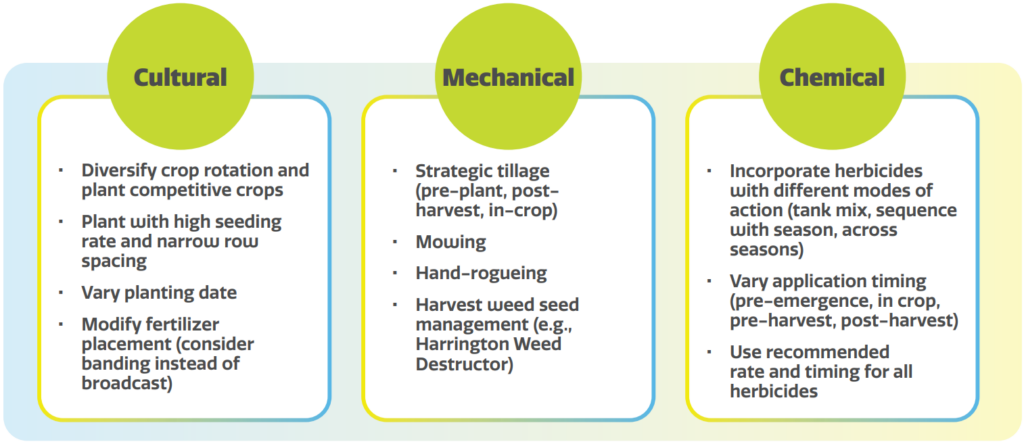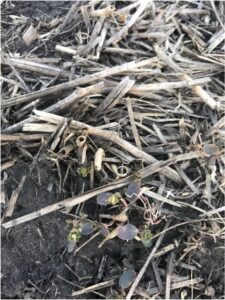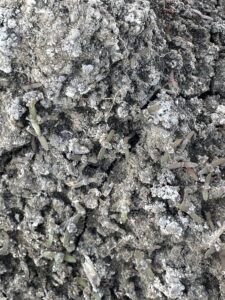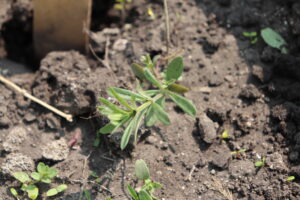Section Title
Top Considerations for Early Season Weed Control in Cereals
- Whole Farm
This document is adapted from a 2020 Alberta Grains webinar presentation from Dr. Breanne Tidemann (Dr. Breanne Tideman - Early season weed control considerations - 'In the Field' webinar (youtube.com)), and was created in collaboration between Manitoba Crop Alliance, Saskatchewan Wheat Development Commission, Saskatchewan Barley Development Commission and Alberta Grains.
Early season weed control can be key to optimizing yield and giving your crop a good head start. Even small weeds compete with your crop for moisture and nutrients while also acting as a host for insects and diseases. Controlling weeds while they are small prevents competition with the crop and in many cases improves herbicide efficacy. This is especially true for some of our more troublesome weeds.
Here are our top considerations for early season weed control:
1. Scout, scout and then go scout again
Scouting is the key to early season weed control. This means boots on the ground and getting out to see what is there (no driving by at 60 km/hr viewing the field from the truck!). Effective weed control relies on knowing what you are dealing with. Make sure to move crop residue around as weeds can be hiding under the stubble. Under cold stress, weeds can be purple in colour rather than green. While this can make them difficult to see, it is still important that they are controlled, so it is critical to scout thoroughly. While scouting, pay special attention to:
Which species are present?
It is important to identify weeds by annual, winter annual or perennial to know what management strategy will work best. Winter annuals include stinkweed, shepherd’s purse, cleavers, downy brome, Japanese brome, and narrow-leaved hawks’ beard. Control of winter annual weeds is usually most effective in the fall. These weeds germinate in the fall and begin growing again very early in the spring. If control of winter annuals is required in the spring, careful attention must be paid to weed staging and herbicide choice, as many herbicides cannot control larger winter annuals.
Perennial weeds such as Canada thistle, dandelion, foxtail barley and perennial sow thistle are also usually best controlled in the fall. Spring application of herbicides can control top growth of perennial weeds, but usually has little effect on the roots. For more information on fall weed control, see our resource on Fall Considerations for Cereals.
Control of annual grass weeds such as green foxtail, yellow foxtail, barnyard grass and wild oats can be challenging in cereal crops, due to a limited number of in-crop herbicide options compared to broadleaf weeds. Early emerging annual broadleaf weeds such as kochia should also be kept on the radar and actively managed. Click here and here for the Manitoba and Alberta weed identification guides.
Figure 1. Left: An example of purple cleavers seedlings emerging under stubble (Photo credit: Breanne Tidemann, AAFC). Right: Kochia seedlings. They can be tricky to see unless you look closely (Photo credit: Jeanette Gaultier, BASF Canada).
Figure 2. Example of young Cleavers (left) and Canada Thistle (right) plants. Cleavers is an example of a winter annual and Canada Thistle is an example of a perennial weed. (Photo credit: Manitoba Crop Alliance).
Stage your weeds
Winter annuals that are already nearing the upper limit of the recommended growth stage on the herbicide label need to be sprayed as soon as possible, while annual weeds just starting to germinate may be able to wait. More information on weed staging can be found below, in the provincial Field Crop Protection guides.
Take note if any new weeds or weed patches have emerged
Do you see something different than expected from previous years? You might notice a different weed profile if the previous harvest had challenging conditions. Conditions conducive to harvest loss from shattering canola may lead to higher numbers of volunteer canola in the following spring. A late harvest may impact the ability to do fall weed control, leading to more weeds present.
Check for signs of herbicide resistance
Do you notice any weed patches that escaped herbicide control last year? One reason for insufficient control is herbicide resistance. When in doubt, send weed seeds to a herbicide resistance testing lab. Knowing the resistance profile of your weeds is crucial for making effective weed management plans. For more information on signs of herbicide resistance click here.
For more tips on scouting for weeds, see this helpful resource from Manitoba Agriculture.
2. Keep an eye on the weather
Weeds are controlled more effectively when they are actively growing. This is especially crucial for systemic herbicides that require translocation within the plant. Freezing temperatures will slow a plant’s metabolism and in turn reduce herbicide efficacy. For pre-seed burnoffs, try to target days without freezing temperatures the day before. If it freezes overnight, wait a half to a full day before applying. It takes some heat and sunlight to get the weeds to actively grow again.
In addition to freezing temperatures, dry conditions can also reduce the efficacy of pre-seed burnoffs. Better herbicide efficacy can be observed if spring snowfall or rain provides sufficient soil moisture for weeds to actively grow. Take temperature and soil moisture into consideration when making decisions on pre-seed herbicides. Keep in mind, the most expensive herbicide you can apply is one that doesn’t work.
Regional weather station data can be found here:
Weather also influences early-season weed control through fall precipitation, which encourages the emergence of winter annuals such as cleavers. For areas that received sufficient fall rain, winter annual weeds might have taken advantage of fall moisture to emerge and develop before overwintering. If that is the case for your farm, pay special attention to scouting winter annual weeds in early spring. Manage them early if control is required.
3. Tank mix multiple effective modes of action
This is your first opportunity in the growing season to prevent herbicide resistance and maintain herbicide stewardship. Resistance is a numbers game. The more weeds you apply a single mode of action to, the more likely it is that you find individual plants with the ability to survive that herbicide. It is crucial to mix multiple effective modes of action to reduce the chance that resistant weeds survive and produce seeds. Be aware of residuals and re-cropping restrictions when choosing tank mix options, especially if you have changed your crop plan recently.
4. Set yourself up for a herbicide layering strategy
In addition to following tip #3 by tank mixing multiple effective modes of action, you can also incorporate a herbicide layering strategy. Herbicide layering uses multiple herbicide groups in sequential applications to defend against weeds. It can be an effective approach to prevent and overcome herbicide resistance. Often herbicide layering involves a soil-applied residual herbicide with a burnoff, followed up by an in-crop application. For example, herbicide layering can be an effective tool for preventing and managing herbicide resistant wild oats. For more information, the Resistant Wild Oat Action Committee has a variety of useful resources including information on active ingredients effective on wild oats and pyroxasulfone for early spring wild oat management. Note that if you plan on incorporating residual products, check the herbicide label and your provincial Guide to Crop Protection for re-cropping restrictions.
5. Emergence timing of weeds vs. crop
Have you thought of the difference the emergence timing of weeds makes? In wheat and barley, research has shown that for every day wild oats emerged prior to the crop, approximately 3 percent more yield is lost (O’Donovan et al, 1985). Wild oat nutrient uptake patterns are similar to cereal crops. Delays in controlling wild oats can result in nutrients intended for the crop being tied up in weed biomass. Early control is a prudent approach from a nutrient management perspective as well as weed management (Schoenau et al, 2009). To make the most of pre-seed burnoff, prioritize fields for spraying based on 1) what’s going to be seeded next; and 2) which field has higher weed pressure based on your thorough scouting from tip #1. Remember that leaving a large gap between pre-seed burnoff and seeding can be risky. Weeds that emerge during that gap gain a competitive advantage against the crop and have far more impact on yield than weeds that come up after the crop.
6. Do what you can to give the crop the edge
Remember that chemical control strategies are not your only option. Chemical control is best used as part of an integrated weed management approach. Early in the season, ensure that you are giving your crop the best chance for success. When determining your seeding rate, remember that your plant stand affects your crop's ability to compete with weeds. Increasing your seeding rate can make sure that your crop has the competitive advantage. Also consider the risk of seedling disease or early-season insects. If conditions are right, consider the use of seed treatments.
Fertilizer management should also be considered – are you using the proper source, rate, time and placement to feed the crop instead of the weeds? Several studies in Alberta show that banding nitrogen fertilizer in winter wheat improves uptake by the crop and reduces weed biomass compared to broadcast (Blackshaw et al, 2005; Beres et al, 2010). Research in spring wheat has shown similar results, and that banding nitrogen fertilizer reduced the weed seedbank compared to surface broadcast over the four-year experiment (Blackshaw et al, 2004).

Figure 3. Integrated weed management incorporates cultural, mechanical and chemical control practices to manage weeds. These are just some of the possibilities.
7. Time crunch – what if you can’t do it all?
In an ideal world, producers would have the time and funds to do all the above as part of an integrated weed management approach. But what should producers focus on if they can’t do it all? If weeds are present and actively growing in the spring, a pre-seed burnoff is more beneficial than an early in-crop herbicide, as weeds use moisture and nutrients that would otherwise be available to your crop (Sapsford et al. 2007).
If early season weed issues are becoming more common on your farm, but you don’t have enough time to tackle them all in the spring, then consider a fall applied soil residual herbicide. Using integrated weed management practices to spread out the work can be beneficial in your battle with weeds, which leads to the next tip.
8. Managing weeds is a season long battle
Early season weed control is vital, but it's just the first battle in a season long war on weeds. Think ahead: which summer, fall, and winter practices can I adopt to help reduce weed pressure next year? Managing the weed seedbank takes year-round strategies. This can involve using multiple herbicide modes of action, tank mixes, cultural and mechanical controls like harvest weed seed control. Maintaining good weed control each year opens your crop and herbicide options for future years.
9. Keep field records
In the season long battle against weeds, accurate and up-to-date field history records are the foundation on which you base your management decisions. The most critical information is crop type, weed species and the active ingredients in all herbicide applications. Herbicide rate applied, and any adjuvant used, are also important. Tips on what to consider when building field records can be found here.
References
- Beres BL, Harker KN, Clayton GW, Bremer E, O’Donovan JT, Blackshaw RE, Smith AM. 2010. Influence of N fertilization on weed growth, grain yield and grain protein concentration in no-till winter wheat. Canadian Journal of Plant Science. 90(5): 637-644.
- Blackshaw RE, Molnar LJ, Janzen H. 2004. Nitrogen fertilizer timing and application method affect weed growth and competition with spring wheat. Weed Science. 52(4): 614-622.
- Blackshaw RE, Molnar LJ, Larney FJ. 2005. Fertilizing, manure and compost effects on weed growth and competition with winter wheat in western Canada. Crop Protection. 24(11): 971-980.
- O’Donovan JT, St. Remy EA, O’Sullivan PA, Dew DA, Sharma AK. 1985. Influence of the relative time of emergence of wild oat (Avena fatua) on yield loss of barley (Hordeum vulgare) and wheat (Triticum aestivum). Weed Science. 33(4): 498-503.
- Sapsford, K.L., F.A. Holm, E.N. Johnson, and G. Cleazy. 2007. Research poster: Timing of Spring Application for Winter Annual Weed Control.
- Schoenau, J.J., A. Bayar, R. Holm, and K. Sapsord. 2009. Wild oat nutrient uptake and release from residue. Soils and Crops Conference Proceedings.
















